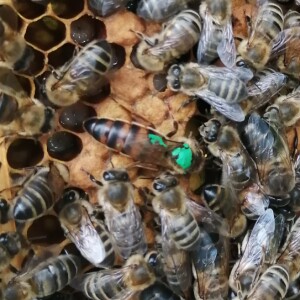Green Spot
It is swarm season. Honeybees reproduce, and maintain the existence of the species, by swarming. At this time of year, an established, healthy colony wants to swarm. When it happens, the queen bee and around half of the workers leave the hive and fly off to find a new home, where they settle and continue as a colony. The remaining workers stay behind and rear a new young queen, who must fly out of the hive to mate, and then return and begin laying to keep the colony in the hive going. The outcome is two colonies from one - an old queen with a colony in a new place, and a new queen with a colony in the old place
For the beekeeper, this is a disaster. Overnight, half of the workforce has walked - well, flown - off the job, never to return. The chance of a honey crop this year is compromised. Worse, the remainder of the colony is at significant risk: by no means all new queens successfully mate and return to the hive. If she does not make it, the colony is doomed
Swarming can be delayed a little, but it cannot be prevented. It can, however, be managed to ensure that the queen and swarm are not lost. There are multiple methodologies for doing this, but they all rely on the same principle. If the beekeeper is alert enough to observe that the bees have entered 'swarm mode' - a swarm is imminent - they can intervene to split the colony into two parts, each one in its own hive (but, most importantly, both of them still in the apiary, not in a hole in a tree somewhere), thereby 'fooling' the bees into believing that they have truly swarmed, and removing the urge to leave the premises
The description of almost all swarm control methods begin with the instruction "First, find the queen". Under the stress created by fear of losing part of the colony, and needing to take action immediately, this can be difficult. Most beekeepers, therefore, mark their queens with a coloured spot on the top of the thorax. Most beekeepers make a better job of applying it that I have in the extra! Functionally, I have done the queen no harm, but this is the equivalent of an amateur decorator splashing wall paint on the ceiling - shoddy workmanship. The paint does wear off in time, I live with the hope that my lack of dexterity will become less obvious
There is quite a lot else going on in the picture. At the base of some of the open cells (zoom in!), you can see the pearly-coloured, C-shaped profile of growing larvae. Several workers have their heads buried in a cell, tending to, and feeding, the larva within. Around the queen are the biscuit-coloured wax cappings that seal the cells where larvae are metamorphosing into adult workers. Just above the queen is a cell where the cap is under construction
I made the bees an extra because I like the rather abstract picture of a plant, fighting its way to confidence that spring is really here, as a main picture. It's nothing to do with hiding my shame from any browsing beekeepers, ok?


Comments
Sign in or get an account to comment.


